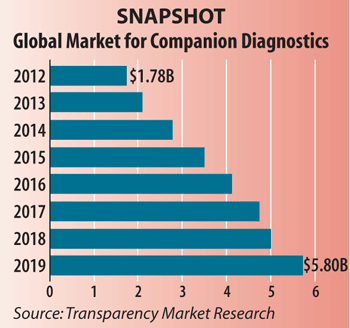Companion Diagnostics Sales to Reach $5.8B
Spurred by a focus on cost reduction by pharmaceutical companies and the rising demand for targeted therapies, the global market for companion diagnostics is expected to grow 18% each year from 2013–2019, reaching an estimated value of $5.8 billion by 2019, according to a new report from Transparency Market Research.
Companion diagnostics for breast cancer and lung cancer will lead the way. In 2012, breast cancer was already the most prominent segment of the market, and extensive research on breast cancer biomarkers will continue to propel the adoption of breast cancer companion diagnostics. There are also more FDA-approved companion tests for breast cancer than for any other indication.

In lung cancer, the report notes an "elaborate pipeline" of related companion diagnostics, estimating that the global market for lung cancer companion diagnostics will grow at a rate of more than 20% from 2013 to 2019. Other cancers driving the market include colorectal, gastric, and melanoma.
By region, North America will likely continue to be the largest market for companion diagnostics, followed by Europe. A large consumer base, higher disposable incomes, increased awareness, presence of suitable infrastructure facilities, and acceptance of novel approaches in medicine will propel rapid development of companion diagnostics in the North American market, analysts predict. By company, Roche and Qiagen look to remain leaders. Other companies to watch include Abbott , Agilent Technologies, Ventana Medical Systems, and Genomic Health.
On the business side, the report forecasts more strategic collaborations among diagnostics companies and pharmaceutical manufacturers—such as Dako's collaboration with AstraZeneca—as well as more mergers and acquisitions, such as GE Healthcare's acquisition of Clarient to focus on cancer diagnostics. Limits on the market include problems with reimbursement, as well as long developmental and approval phases due to the complexities of targeted therapies.